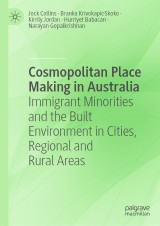Details

Cosmopolitan Place Making in Australia
Immigrant Minorities and the Built Environment in Cities, Regional and Rural Areas|
106,99 € |
|
| Verlag: | Palgrave Macmillan |
| Format: | |
| Veröffentl.: | 23.10.2020 |
| ISBN/EAN: | 9789811580413 |
| Sprache: | englisch |
Dieses eBook enthält ein Wasserzeichen.
Beschreibungen
<p>This book looks at the historical and contemporary impact of minority immigrant and ethnic communities on the built and social environment in Australian cities, rural and regional areas. The emphasis is on the changing social use of these buildings – places of worship, ethnic clubs and community associations, immigrant restaurants and retail outlets, museums, memorials and landmarks and other places and spaces created by immigrant communities – rather than on their architectural merit. These places and spaces are sites of bridging and bonding social capital, of social interaction between immigrant communities and their local communities. In both the Australian cities and the ‘bush’ (an Australian colloquial term for non-metropolitan dwellers), the book investigates how the places built and used by minority ethnic communities have transformed Australian life in complex and sometimes contradictory ways. In Sydney, Brisbane and Perth, the book investigates the historical development ofChinatowns and their contemporary dynamics.</p>
Chapter 1. Place Making, Migration and the Built Environment: An Introduction.- Chapter 2. Immigrants and the built environment in New South Wales.- Chapter 3. Immigrants and the built environment in Queensland.- Chapter 4. Immigrants and the built environment in Western Australia.- Chapter 5. Minority immigrants and the Australian built environment.
<p></p><p><b>Jock Collins</b>, Professor of Social Economics, UTS Business School,Australia. </p>
<p><b>Branka Krivokapic-Skoko</b>, Associate Professor, School of Management and Marketing, CSU, Australia.</p>
<p><b>Dr. Kirrily Jordan</b>, Centre for Aboriginal Economic Policy Research, ANU, Australia.</p>
<p><b> Professor Hurriyet Babacan</b>, Rural Economies Centre of Excellence, JCU, Australia.</p>
<p><b>Narayan Gopalkrishnan</b>, Cairns Institute, JCU, Australia. </p><br><p></p>
<p><b>Branka Krivokapic-Skoko</b>, Associate Professor, School of Management and Marketing, CSU, Australia.</p>
<p><b>Dr. Kirrily Jordan</b>, Centre for Aboriginal Economic Policy Research, ANU, Australia.</p>
<p><b> Professor Hurriyet Babacan</b>, Rural Economies Centre of Excellence, JCU, Australia.</p>
<p><b>Narayan Gopalkrishnan</b>, Cairns Institute, JCU, Australia. </p><br><p></p>
<p>This book looks at the historical and contemporary impact of minority immigrant and ethnic communities on the built and social environment in Australian cities, rural and regional areas. The emphasis is on the changing social use of these buildings – places of worship, ethnic clubs and community associations, immigrant restaurants and retail outlets, museums, memorials and landmarks and other places and spaces created by immigrant communities – rather than on their architectural merit. These places and spaces are sites of bridging and bonding social capital, of social interaction between immigrant communities and their local communities. In both the Australian cities and the ‘bush’ (an Australian colloquial term for non-metropolitan dwellers), the book investigates how the places built and used by minority ethnic communities have transformed Australian life in complex and sometimes contradictory ways. In Sydney, Brisbane and Perth, the book investigates the historical development ofChinatowns and their contemporary dynamics.</p><p><b>Jock Collins</b>, Professor of Social Economics, UTS Business School,Australia.</p><p><b>Branka Krivokapic-Skoko</b>, Associate Professor, School of Management and Marketing, CSU, Australia.</p><p><b>Dr. Kirrily Jordan</b>, Centre for Aboriginal Economic Policy Research, ANU, Australia.</p><p><b> Professor Hurriyet Babacan</b>, Rural Economies Centre of Excellence, JCU, Australia.</p><p></p><p><b>Narayan Gopalkrishnan</b>, Cairns Institute, JCU, Australia. </p><div><br></div>
Examines the historical and contemporary impact of minority ethnic communities to the built and social environment in Australian cities, rural and regional areas Investigates what we call ethnic precincts such as Chinatown as a clustered form of Australia’s ethnic community heritage Looks at the places and spaces they create Australia’s rural and regional areas

















